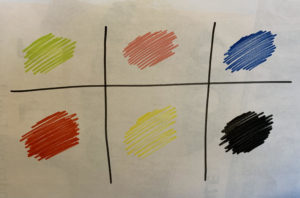These activities are for the week commencing Monday 22 February, which is when we return to Nursery/Remote Learning, following the half term break. We hope that you have a good break over half term and find a new place to visit on one of your local walks!
A few weeks ago, we read ‘Dear Zoo’ and had to match some animals to the noises that they make in a listening game. This week, we’re going to think about some more sounds, but not just animal noises. In our story this week, poor Mr Bear just can’t get to sleep because there are so many noises keeping him awake!

If you’d prefer to download all of this week’s activities in a pdf, please use this link.
You may have a copy of this classic children’s book at home, but don’t worry if not, you can enjoy listening to it using this link. ‘Peace at Last’
Reading
- What happened at the beginning of the story? Why couldn’t Mr Bear get to sleep next to Mrs Bear? Do you snore like Mrs Bear? Have a try!
- What was Baby Bear pretending to be? See if you can make the same noise.
- When Mr Bear went downstairs, what noise could he hear in the living room?
- Can you remember which room Mr Bear was in when he heard ‘DRIP DRIP’ and ‘HMMMMMMMMMM’?
- Outside, Mr Bear heard 3 different animal noises. Can you name them? They made these noises…TOO-WHIT-TOO-WHOO, SNUFFLE SNUFFLE and MIAAAAOW!
- Talk about what happened at the end of the story. Did Mr Bear get to sleep? Did the ending make you laugh? Why?
Phonics
This week, Mrs Gosper is going to teach you about a selection of percussion instruments. Listen carefully to the sounds that they make and then see if you can work out which instrument it is.
Metal and Wood instruments video
There’s a phonics activity included in our Key Worker video this week. It’s linked to our story of the week and is all about listening for sounds around your home. You could join in too; use a tablet/phone to record some sounds around the house and then play them back. Can you guess which sound it is?
Mark-Making
- We all love to snuggle up under our favourite blanket or duvet at bedtime – we saw some really cosy blankets on our Zoom scavenger hunts. Grab a piece of paper and have a go at designing a new blanket. What colours, patterns, shapes or pictures would you use?
- Mr Bear hears lots of animals outside in the garden at night. Can you draw a hedgehog with lots of prickles on its back? Join in with Squiglet and watch how she draws grass using zig-zags.
Mathematics
This week in maths, we’re going to think about some important mathematical language involving words associated with time. During everyday conversations, try to use words like ‘today’, ‘tomorrow’ and ‘yesterday’ and help your child to understand what they mean and use them in conversation.
It’s also important to begin to understand about our daily routines. ‘Peace at Last’ takes place at night time, just as Mr Bear is trying to get to sleep. It’s good to establish a good bedtime routine, but everybody might do things slightly differently! Talk to your child about their evening routine. What do they do first? What happens next? What things do you do together before they go to sleep? Here’s Mr Tumble’s bedtime routine; is it similar to yours?
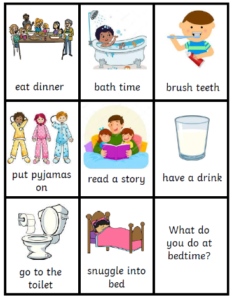
Have a look at these pictures and choose ones that are appropriate for your family. Try to put them in the order that you do them. You might need to add in some different ones, such as taking off your glasses.
Extension ideas
– Can you sequence your morning routine? What do you do first? What next? When do you have breakfast and brush your teeth?
– Don’t forget to keep practising your counting skills! You could count the number of spikes on your playdough hedgehog or roll a dice and draw that many spikes onto a hedgehog outline.
Creative
- Paint/draw/collage a night time picture. What colours will you use for the sky? Would you see a sunshine at night? What animals might you include that are awake at night?
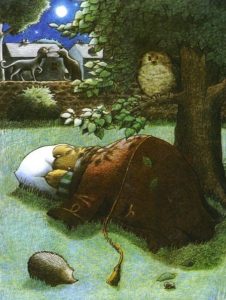
- A few weeks ago, we experimented with printing using different objects to see what shape print they made. This week, try printing using a fork. What pattern does it make? Use the fork to add some spikes onto a hedgehog outline.
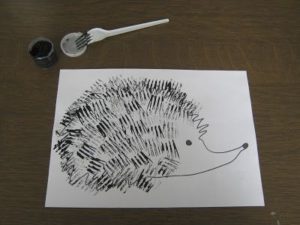
- Use playdough to make a hedgehog. What could you use to make spikes? In Nursery, we sometimes use wooden craft sticks, pipe cleaners or dry penne pasta/spaghetti. There are lots of ideas if you do a Google search! If you have some children’s plastic scissors, you could try rolling a ball and then snipping the top to make spikes.
- We love being all snuggly in our favourite pyjamas and reading a book before bedtime. Why not start your bedtime routine a little bit earlier one night; enjoy a bubbly bath and then make some hot chocolate or warm milk to drink whilst reading your bedtime story. What happens when you add the chocolate powder to the milk?
- In this episode of ‘Melody’, Melody can’t get to sleep so her mum tries a few things to help her feel sleepy. She listens to some music about the moon at night time. What does the music make you think of?
Understanding the World
Talk about animals that are awake at night and sleep during the day. These animals are called ‘nocturnal’ animals; follow the links below to watch some short clips all about animals that come out at night.
Andy’s Secret Hideout – Hedgehogs
Need a longer break? We love watching Aunty Mable and her adventures with Pippin, regardless of how old they are! Grab your fruit snack and learn about hedgehogs with Pippin.
Physical Development
Fiddly Fingers
We’re going to revisit our cutting skills this week and practise using scissors again. Make sure a grown up is around to supervise. Fold a piece of paper in half and cut out a semi-circle shape (or use a paper plate folded in half if you have one). Cut the corner off to make a nose (as in picture) and draw on a face. Next, ask your child to make snips along the edge to create spikes.
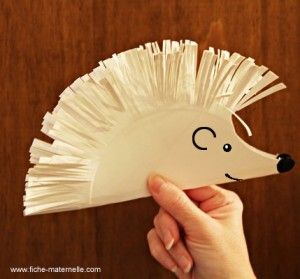
Movement
We’ve had some very cold weather over the last few weeks, but it’s still really important that we get outside to enjoy running around. Whatever the weather, try to wrap up warm and enjoy some fresh air and exercise. If it’s not too icy, have you got a bike, trike or scooter that you could have a ride on? Make sure you wear your helmet. Here are a few ideas, there’s a different one for each day.
Independence skills
We’ve been talking about some of the things that we do as part of our daily routines. What do we do twice a day that is really important? That’s right! We brush our teeth. Whilst we don’t expect children to do this by themselves just yet, they still need adults to ensure it is done well, children could begin to have a go at brushing their teeth before and after their adult has helped. Watch this video and then encourage your child to look in the mirror as they brush their teeth. Teaching children about basic personal hygiene is a really important; it’s included in the ‘health and self-care’ part of the Early Years Foundation Stage.
Key Worker activity and videos
For this week’s Key Worker activity, you’ll need to have listened to this week’s story, ‘Peace at Last’. Mrs Gosper is going to play some sounds from the story and you need to use your listening ears to work out what you heard.
Key Worker video – Peace at last
After you’ve watched the video, you could play a game of ‘I can hear with my little ear’. Take it in turns to imitate something and guess what makes that sound. You could imitate the sound of things from around your house like a clock or telephone, or of recognisable animals like a cat, dog or owl.
During group time, we often sing songs linked to our learning. This one is all about the things we might do at bedtime.
Key Worker song – The way we wash our hands
Friday Story Time
Miss Backhouse is going to read this week’s story and just like ‘Peace at Last’, it’s all about different sounds that we might hear around our homes. Find a comfortable space to sit and enjoy listening to the story, ‘Quiet’ by Kate Alizadeh. Story time – Quiet
Zoom sessions (for children learning at home)
We’re going to play a game of ‘Colour Bingo’. Before the meeting, you’ll need to quickly draw a 3×2 grid and ask your child to draw a different colour into each section. We’ll then reveal some colours during our Zoom and you can tick them off.
